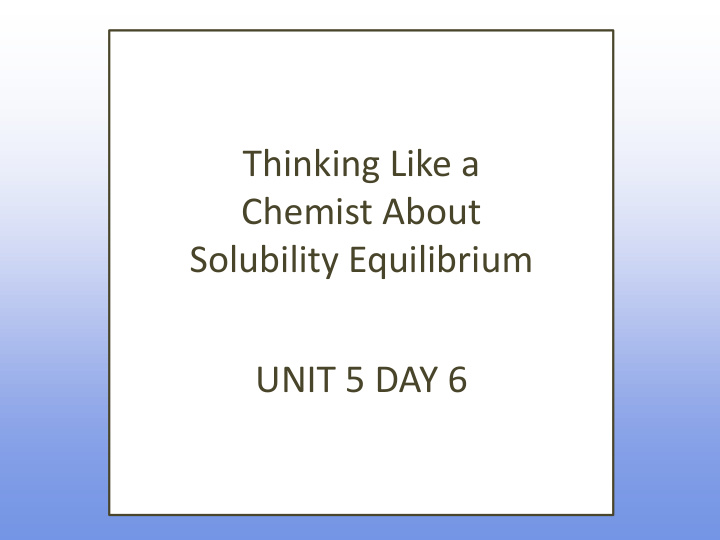



Thinking Like a Chemist About Solubility Equilibrium UNIT 5 DAY 6
What are we going to learn today? Thinking Like a Chemist in the Context of the Solution Equilbria Concept of Solubility Modeling Ionic Reactions Solubility Product Constant
Independent Quiz: Clicker Question 13, NO TALKING When comparing the free energy of the pure solvent to the free energy of a solution formed by dissolving a solid solute in the solvent, the free energy of the solution is: A. Higher B. No difference C. Lower D. Follows no trend, you need to calculate
Independent Quiz: Clicker Question 14, NO TALKING Which would you expect to have the lowest vapor pressure? A. 4 M sugar aqueous solution B. 0.75 M KCl aqueous solution C. 0.25 M CaCl 2 aqueous solution D. 1.5 M MgCl 2 aqueous solution
Imagine you have a beaker that contains water and lots of NaCl. You stir for hours to get the salt to dissolve. In the end, the solution still contains some amount of solid NaCl that won ’ t dissolve. We call such a solution a saturated solution .
Poll: Clicker Question 15 What will happen if I add even more solid salt to an already saturated solution? a. A little more of the salt will dissolve. b. The solution will become less saturated c. The concentration of the salt will remain the same. d. Can ’ t answer without knowing the solubility of the salt.
Solubility The amount of solute that will dissolve in a given amount of solvent or solution We will discuss almost exclusively the solubility of compounds in water Solubility: Often given in grams of solute per liter solution For example: the solubility of KBr in water is 678g/L! Molar Solubility: is the number of moles of solute that will dissolve in 1 L solvent. For example: the molar solubility of KBR is 5.7 M.
Solubility Solubilities are given for saturated solutions They depend on temperature These systems are also in dynamic equilibrium Rate of solute dissolving = Rate of solute recrystallizing
START WORKING ON ACTIVITY Rock (CaCO 3 ) in water versus salt (CaCl 2 )
Poll: Clicker Question 16 How much of the rock dissolved? A. None of the rock dissolved B. All of the rock dissolved C. A tiny amount dissolved
Compare solubilities… model with reaction: CaCl 2 (s) Ca 2+ (aq) + 2Cl - (aq) CaCO 3 (s) Ca 2+ (aq) + CO 3 2- (aq)
Poll: Clicker Question 17 The molar solubility of CaCl 2 is: A. 0.40 M B. 0.65 M 3.6 x 10 -3 M C. D. 1.5 M E. 5.1 M
Poll: Clicker Question 18 K sp = 8.7 x 10 -9 CaCO 3 (s) Ca 2+ (aq) + CO 3 2- (aq) Set up the K sp expression. Solve for molar solubility of CaCO 3 . a. 9.3 x 10 -5 b. 9.3 x 10 5 c. 4.4 x 10 -9 d. Not enough information e. Insoluble means not soluble, so it is 0
CH302 Vanden Bout/LaBrake Spring 2012
Poll: Clicker Question 19 Given a generic formula, AX 2 , where A is the cation and X is the anion, and the molar solubility has been determined to be 1 X 10 -4 M. Calculate the value of the Ksp. A. K sp = 1 x 10 -4 B. K sp = 1 x 10 -8 C. K sp = 2 x 10 -4 D. K sp = 4 x 10 -8 E. K sp = 4 x 10 -12
Poll: Clicker Question 20 Which of the following compounds has the lowest molar solubility? A. AgCl K sp = 1.8 x 10 -10 B. FeS K sp = 8.0 x 10 -19 C. LiF K sp = 1.8 x 10 -3| D. ZnSe K sp = 2.0 x 10 -25
Poll: Clicker Question 21 Which of the following compounds has the lowest molar solubility? A. AgCl K sp = 1.8 x 10 -10 B. Cd 3 (PO 4 ) 2 K sp = 2.5 x 10 -30 C. Zn(OH) 2 K sp = 3.0 x 10 -17 D. ZnSe K sp = 2.0 x 10 -25
How did you know that so fast? Quick way to estimate using your exponent math skills.
What did we learn today? Solubility is an equilibrium condition. Quantify the solubility using equilibrium constant, K. K is “Ion Product” = product of the ions in solution
Learning Outcomes Understand the concept of the ion product. Write formula unit, total ionic and net ionic reactions, and identify spectator ions.
IMPORTANT INFORMATION LM09 and HW2 due this morning LM11 and LM12 posted. HW 3 posted. Looking ahead: EXAM 1, TUESDAY Feb 4 th 7 – 9 PM Details of room assignments will be posted on website next week
Recommend
More recommend